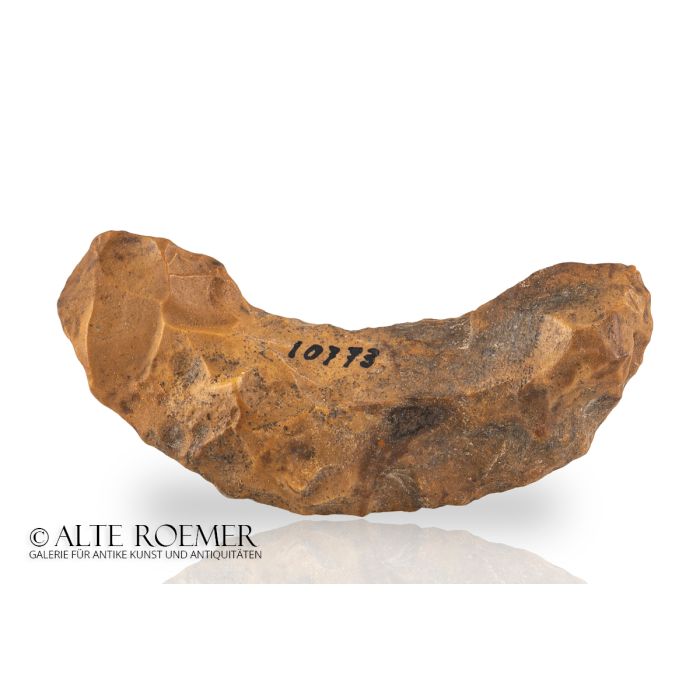Stone Age bow scraper from Egypt
Price: on request
Sold
Object number
AR3355-02
| Object: |
Stone Age bow scraper from Egypt
|
| Material: |
Flint.
|
| Period: |
Roughly 18,000 BC to 10,000 BC. Towards the end of the North African Paleolithic. However, the artefact is difficult to date. The older literature assumes a significantly earlier dating for this type, whereas the more recent literature is no longer specific and does not rule out a dating to the younger Stone Age. |
| Description: |
Worked stone of crescent shape. The convex and concave side worked as a blade. The artefact was once mounted and used as a scraper or knife.
|
| Dimensions: |
83mm wide.
|
| Condition: |
Perfect state. No modern damage. Modern black inscription "10773".
|
| Provenance: |
Acquired by us on the Swiss art market in 2022. Previously in the Swiss collection of Alfred Huber, acquired in 1998 when Mr. Huber was director of the Burghalde Museum in Lenzburg, Switzerland. The acquisition was made from the collection of the Bally-Prior Museum in Schönenwerd, Switzerland. Added to the museum collection between 1860 and 1926. Thebes in Egypt has been handed down as the place of origin. This can be seen from an associated museum display (not included here, it is part of our object number AR3355-01). An invitation and encouragement to devote oneself to the study of art and nature and to love the subject. This is what the Bally-Prior Museum should be for the youth. And this is why the founder of the museum granted free admission to young visitors. He himself, Peter Eduard Bally-Prior (1847-1926), began collecting early in his life. He passionately devoted himself to minerals, fossils, as well as archaeological and ethnological rarities. His successful career as an industrialist and Swiss National Council gave him ample funds for his passion. He financed six large archaeological excavations in Switzerland and took the time to write accademic publications on history. The Bally-Prior Museum in Schönenwerd Switzerland opened in 1910 to make the already huge collection accessible to the public. Shortly before the death of the founder in 1926, the museum opened a new wing to accommodate new additions to the collection. After almost a century, in 1998, the museum foundation decided to close down and sell the exhibits. Museums, universities and private individuals rushed to acquire a part. It was people who had love for the subject. Exactly the passion Eduard Bally-Prior wanted to awaken with his museum. |
| Literature: |
Cf. Meyers Konversationslexikon (6th edition from 1902), plate "Kultur der Steinzeit I", related to the article "Steinzeit", no. 6. The specimen shown there also comes from Thebes. It is dated in the lexicon to the earlier Palaeolithic, but the chronology of Stone Age artefacts from North Africa has changed significantly since the time of printing. Similar C. E. Klenkler, Sahara - Prähistorische Artefakte 2, p. 173. |
| Authenticity: |
We unconditionally guarantee the authenticity of every artefact, all items are subject to our lifetime return policy on authenticity.
|


